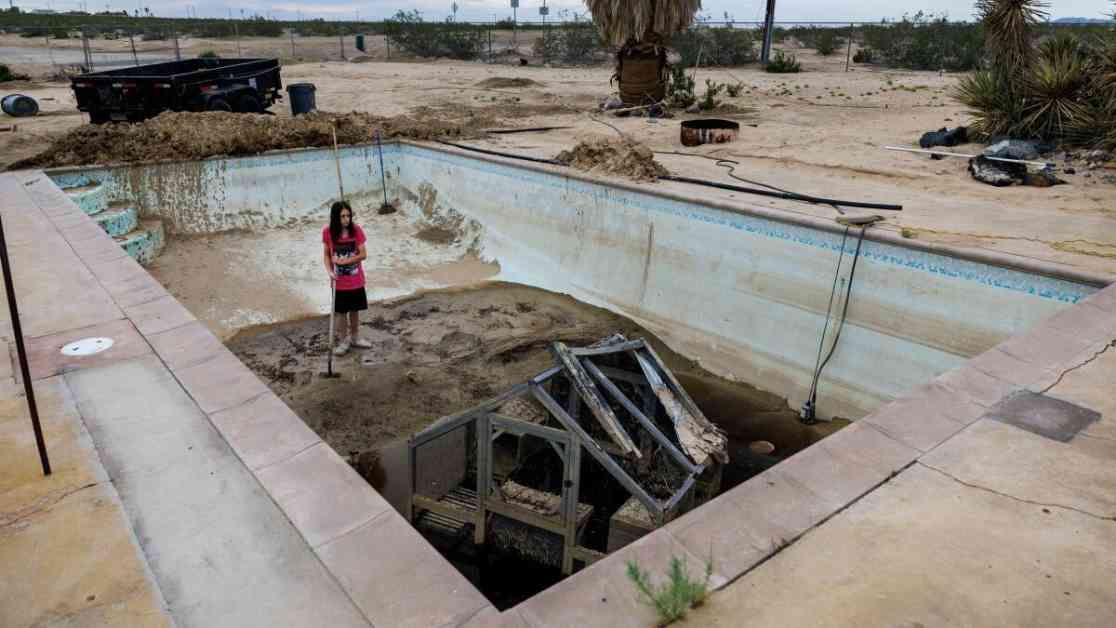In the midst of summer, most Southern Californians are accustomed to clear skies and sweltering heat, with the occasional haze of wildfire smoke lingering in the air. However, on July 14 in Twentynine Palms, a sudden and intense thunderstorm unleashed a deluge of rain, totaling approximately 1.88 inches in just a couple of hours. This amount of rainfall was unprecedented for the town, which typically receives less than 4 inches of rain throughout an entire year. The downpour resulted in flooding along streets and highways, sweeping away cars and causing damage to homes and businesses. Just nine days later, the area was once again under a flash flood warning as another thunderstorm rolled through, compounding the challenges faced by residents in the aftermath of the initial flooding.
The Mojave Desert, known for its extreme aridity, experiences these unexpected bursts of summer rain as part of the North American monsoon phenomenon. This unique weather pattern brings vital moisture to regions that would otherwise be parched, but it also poses a risk of destructive flooding. While the North American monsoon may not be as well-known as its South Asian counterpart, its impact on the climate of the Four Corners states, including California, Arizona, and New Mexico, is significant.
Late summer is typically the driest time of year for much of California, including Los Angeles, where the month of August sees little to no rainfall on average. However, as one travels eastward into San Bernardino County, the weather pattern shifts dramatically. In Twentynine Palms, August emerges as the wettest month, with a notable increase in precipitation. This trend continues as one moves into Arizona and New Mexico, where late summer rainfall becomes even more pronounced. In Santa Fe, almost half of the annual rainfall occurs between July and September, highlighting the importance of the North American monsoon in shaping regional climates.
The North American monsoon is driven by temperature differentials between land and ocean surfaces. During the hot summer months, the sun’s energy heats the subtropical regions, with a significant portion of this heat being absorbed by the land or ocean surfaces. On land, the top layers of soil or rock rapidly warm up, leading to the ascent of warm air in the late afternoon. This rising air draws in moisture from bodies of water such as the Gulf of California, fueling the development of thunderstorms when it encounters mountainous terrain in northern Mexico and the American Southwest.
One key factor that distinguishes regions experiencing monsoons from those that do not is topography. The presence of geographical features like the Himalayas in South Asia acts as a barrier, enhancing the intensity and consistency of the monsoon in that region. In contrast, coastal California, including Los Angeles, is shielded from the effects of the North American monsoon by the North Pacific High, a high-pressure system that dominates the region in the summer months. This atmospheric phenomenon suppresses the monsoonal moisture, resulting in the dry conditions typically observed in coastal areas.
The subtropical ridge, a series of persistent high-pressure systems located around 30 degrees north and south of the equator, also plays a crucial role in modulating monsoonal activity. In the case of the North American monsoon, the North Pacific High associated with the subtropical ridge hinders the penetration of monsoonal moisture into coastal California, redirecting it towards inland areas. During the winter months, the North Pacific High weakens and shifts southward, allowing for the influx of atmospheric rivers that bring moisture to the state.
The North American monsoon presents a mixed blessing for the Southwest, as it delivers much-needed rainfall to the region but also poses the risk of flash floods due to the rapid accumulation of precipitation. The hard-packed soil in arid environments like the Mojave Desert struggles to absorb the sudden influx of water, leading to potentially hazardous flooding events that can damage infrastructure and threaten lives. While the monsoon’s rain and cooler temperatures can aid in extinguishing wildfires, the accompanying lightning strikes can serve as ignition sources for new fire outbreaks.
Climate change is anticipated to have an impact on monsoonal rainfall patterns, although the specific effects may vary depending on local conditions. In some regions like South and East Asia, monsoons are projected to intensify due to climate change, influenced in part by changes in aerosol pollution. Conversely, the North American monsoon is predicted to experience a reduction in total precipitation, with estimates suggesting a 1%-6% decrease in summer rainfall. This trend could exacerbate challenges faced by regions reliant on monsoonal rainfall, including increased pressure on water resources such as the Colorado River watershed.
As the North American monsoon potentially weakens in the coming decades, it underscores the importance of proactive measures to mitigate the impact of climate change on vulnerable ecosystems and communities. The delicate balance of moisture delivery and flood risk associated with the monsoon highlights the need for adaptive strategies and sustainable practices to safeguard against the consequences of shifting weather patterns. By understanding the dynamics of the North American monsoon and its implications for the region, stakeholders can better prepare for the challenges posed by a changing climate and work towards resilient solutions for a sustainable future.



























